Financial Accounting Report: Munteanu Ltd. and Bank Reconciliation
VerifiedAdded on 2021/02/22
|15
|3862
|115
Report
AI Summary
This report delves into the core principles of financial accounting, exploring the preparation of final accounts, bank reconciliation processes, and the application of accounting concepts. It begins with an introduction to financial accounting, emphasizing its role in decision-making and financial governance. The report then covers the preparation of financial statements (income statement and balance sheet) for Munteanu Ltd., along with the importance of accounting concepts such as consistency and prudence. It details the meaning and purpose of depreciation, including various methods like straight-line and diminishing balance. Furthermore, the report addresses the differences in financial statement preparation between sole traders and limited companies. The report also explains the bank reconciliation process and its importance for identifying and correcting errors in financial records. Finally, the report covers reconciliation of control accounts and clearing suspense accounts using provided examples.
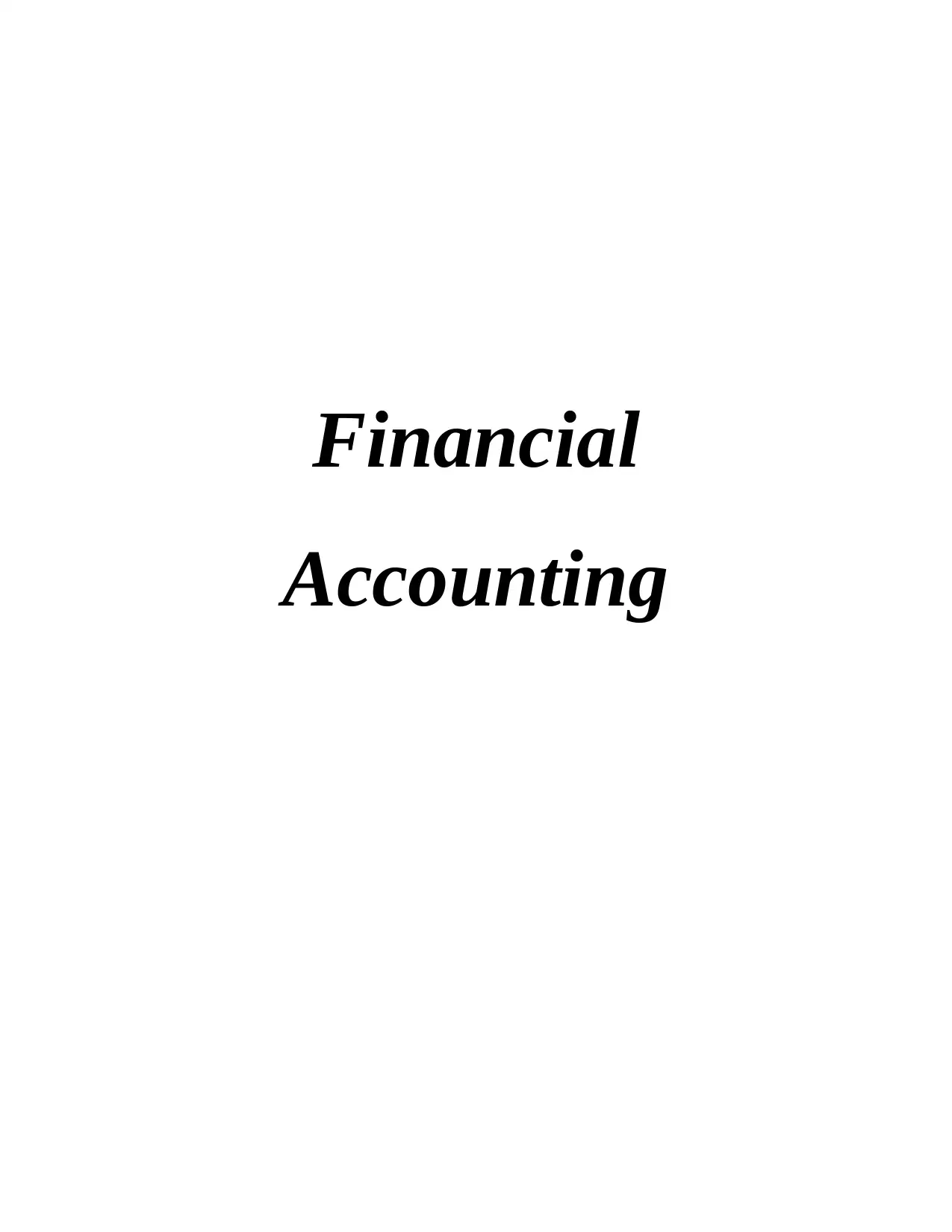
Financial
Accounting
Accounting
Paraphrase This Document
Need a fresh take? Get an instant paraphrase of this document with our AI Paraphraser
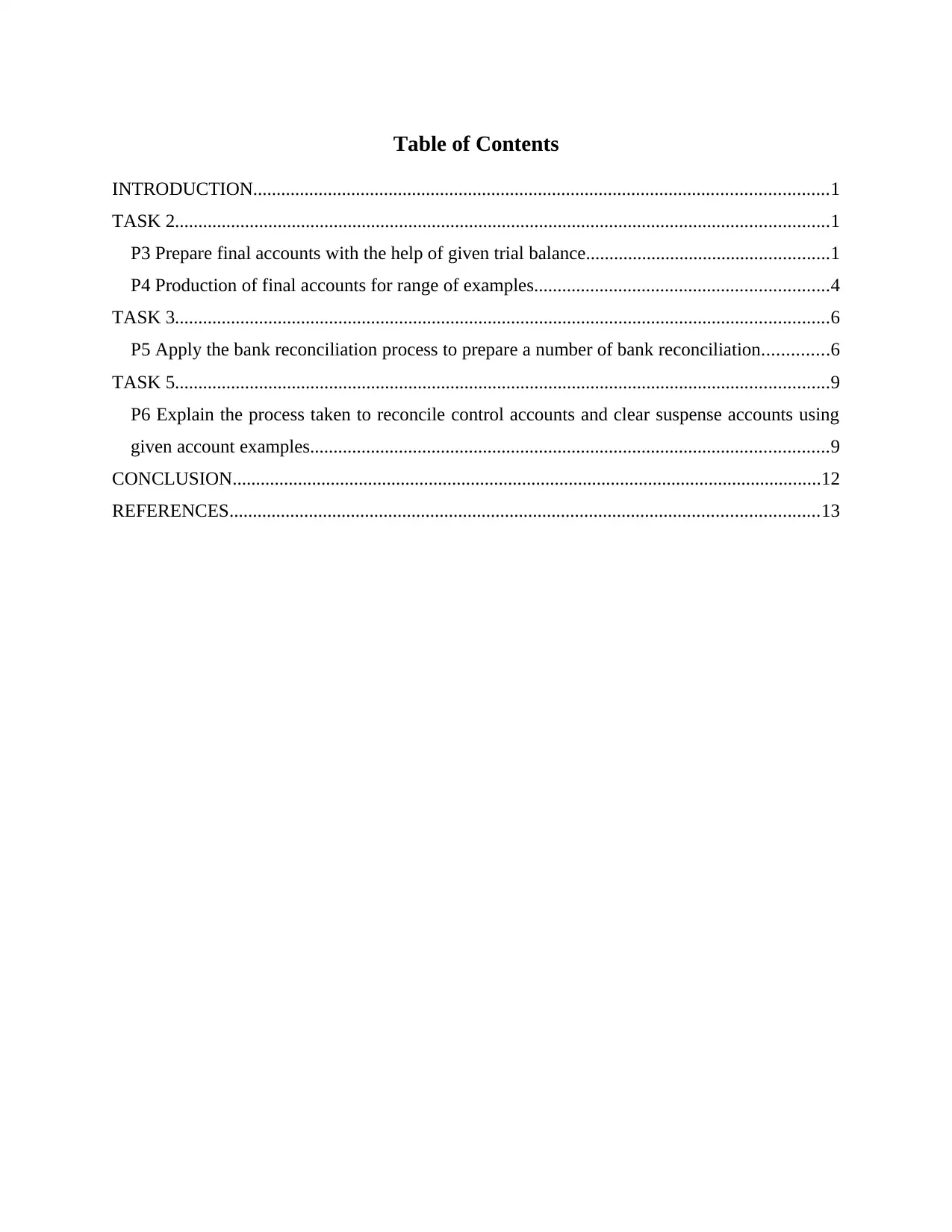
Table of Contents
INTRODUCTION...........................................................................................................................1
TASK 2............................................................................................................................................1
P3 Prepare final accounts with the help of given trial balance....................................................1
P4 Production of final accounts for range of examples...............................................................4
TASK 3............................................................................................................................................6
P5 Apply the bank reconciliation process to prepare a number of bank reconciliation..............6
TASK 5............................................................................................................................................9
P6 Explain the process taken to reconcile control accounts and clear suspense accounts using
given account examples...............................................................................................................9
CONCLUSION..............................................................................................................................12
REFERENCES..............................................................................................................................13
INTRODUCTION...........................................................................................................................1
TASK 2............................................................................................................................................1
P3 Prepare final accounts with the help of given trial balance....................................................1
P4 Production of final accounts for range of examples...............................................................4
TASK 3............................................................................................................................................6
P5 Apply the bank reconciliation process to prepare a number of bank reconciliation..............6
TASK 5............................................................................................................................................9
P6 Explain the process taken to reconcile control accounts and clear suspense accounts using
given account examples...............................................................................................................9
CONCLUSION..............................................................................................................................12
REFERENCES..............................................................................................................................13
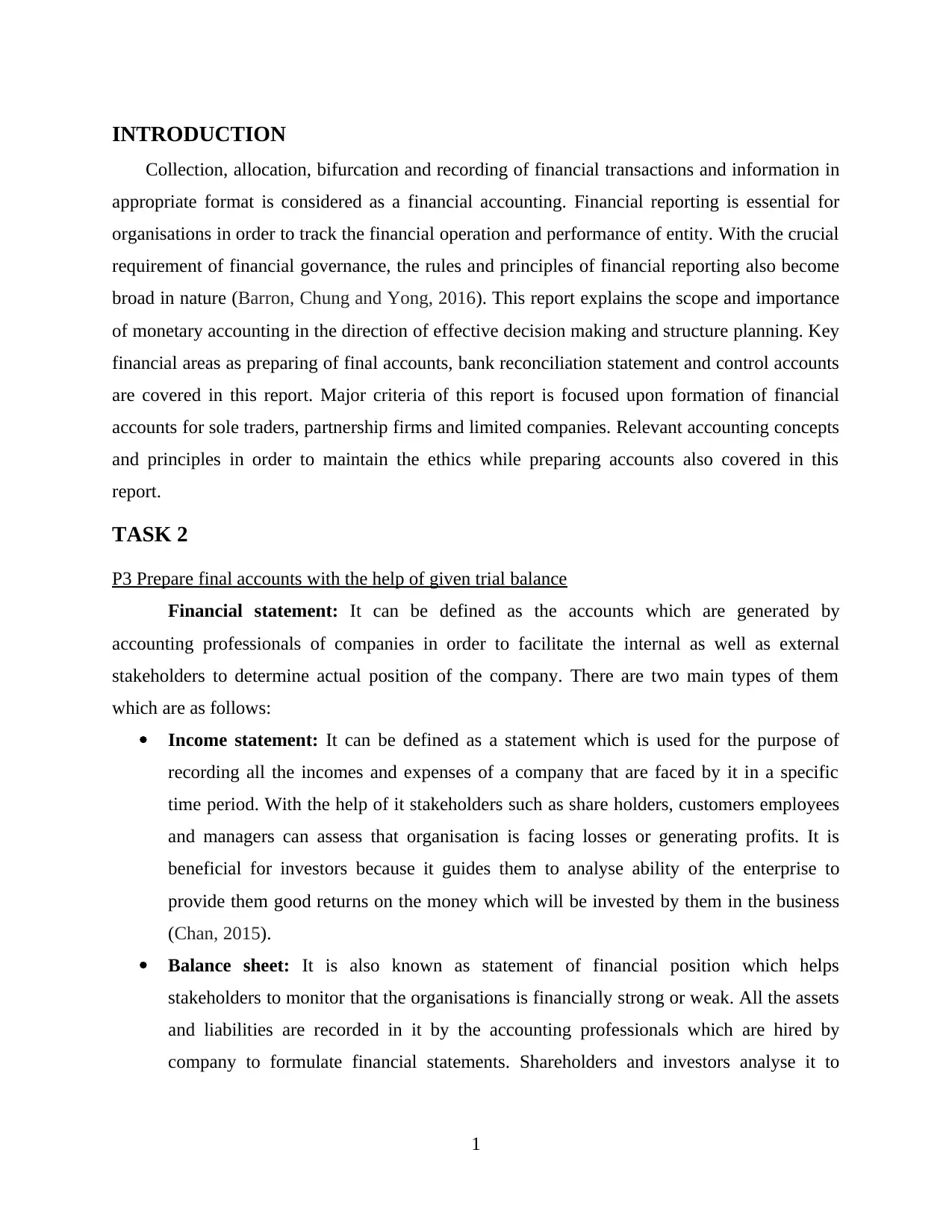
INTRODUCTION
Collection, allocation, bifurcation and recording of financial transactions and information in
appropriate format is considered as a financial accounting. Financial reporting is essential for
organisations in order to track the financial operation and performance of entity. With the crucial
requirement of financial governance, the rules and principles of financial reporting also become
broad in nature (Barron, Chung and Yong, 2016). This report explains the scope and importance
of monetary accounting in the direction of effective decision making and structure planning. Key
financial areas as preparing of final accounts, bank reconciliation statement and control accounts
are covered in this report. Major criteria of this report is focused upon formation of financial
accounts for sole traders, partnership firms and limited companies. Relevant accounting concepts
and principles in order to maintain the ethics while preparing accounts also covered in this
report.
TASK 2
P3 Prepare final accounts with the help of given trial balance
Financial statement: It can be defined as the accounts which are generated by
accounting professionals of companies in order to facilitate the internal as well as external
stakeholders to determine actual position of the company. There are two main types of them
which are as follows:
Income statement: It can be defined as a statement which is used for the purpose of
recording all the incomes and expenses of a company that are faced by it in a specific
time period. With the help of it stakeholders such as share holders, customers employees
and managers can assess that organisation is facing losses or generating profits. It is
beneficial for investors because it guides them to analyse ability of the enterprise to
provide them good returns on the money which will be invested by them in the business
(Chan, 2015).
Balance sheet: It is also known as statement of financial position which helps
stakeholders to monitor that the organisations is financially strong or weak. All the assets
and liabilities are recorded in it by the accounting professionals which are hired by
company to formulate financial statements. Shareholders and investors analyse it to
1
Collection, allocation, bifurcation and recording of financial transactions and information in
appropriate format is considered as a financial accounting. Financial reporting is essential for
organisations in order to track the financial operation and performance of entity. With the crucial
requirement of financial governance, the rules and principles of financial reporting also become
broad in nature (Barron, Chung and Yong, 2016). This report explains the scope and importance
of monetary accounting in the direction of effective decision making and structure planning. Key
financial areas as preparing of final accounts, bank reconciliation statement and control accounts
are covered in this report. Major criteria of this report is focused upon formation of financial
accounts for sole traders, partnership firms and limited companies. Relevant accounting concepts
and principles in order to maintain the ethics while preparing accounts also covered in this
report.
TASK 2
P3 Prepare final accounts with the help of given trial balance
Financial statement: It can be defined as the accounts which are generated by
accounting professionals of companies in order to facilitate the internal as well as external
stakeholders to determine actual position of the company. There are two main types of them
which are as follows:
Income statement: It can be defined as a statement which is used for the purpose of
recording all the incomes and expenses of a company that are faced by it in a specific
time period. With the help of it stakeholders such as share holders, customers employees
and managers can assess that organisation is facing losses or generating profits. It is
beneficial for investors because it guides them to analyse ability of the enterprise to
provide them good returns on the money which will be invested by them in the business
(Chan, 2015).
Balance sheet: It is also known as statement of financial position which helps
stakeholders to monitor that the organisations is financially strong or weak. All the assets
and liabilities are recorded in it by the accounting professionals which are hired by
company to formulate financial statements. Shareholders and investors analyse it to
1
⊘ This is a preview!⊘
Do you want full access?
Subscribe today to unlock all pages.

Trusted by 1+ million students worldwide
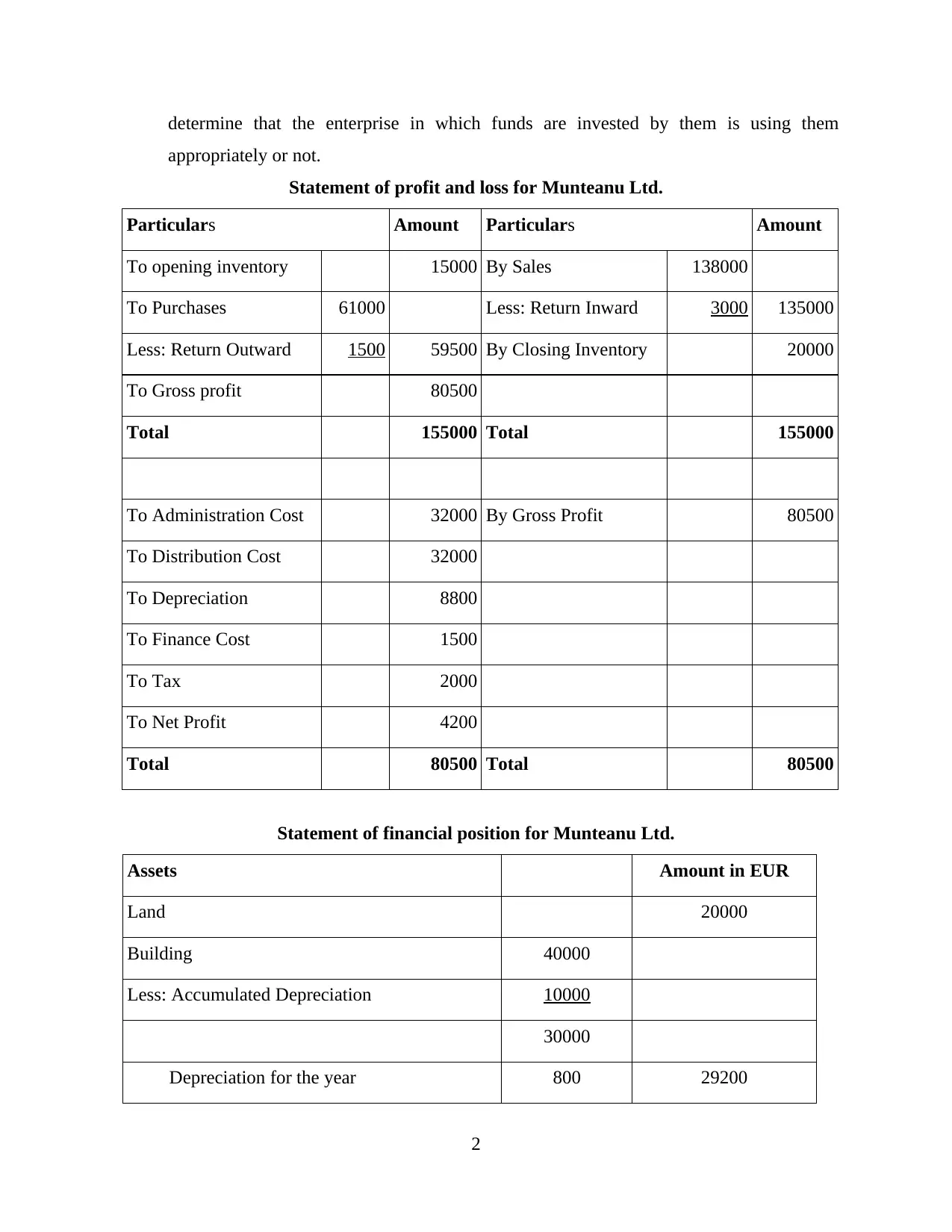
determine that the enterprise in which funds are invested by them is using them
appropriately or not.
Statement of profit and loss for Munteanu Ltd.
Particulars Amount Particulars Amount
To opening inventory 15000 By Sales 138000
To Purchases 61000 Less: Return Inward 3000 135000
Less: Return Outward 1500 59500 By Closing Inventory 20000
To Gross profit 80500
Total 155000 Total 155000
To Administration Cost 32000 By Gross Profit 80500
To Distribution Cost 32000
To Depreciation 8800
To Finance Cost 1500
To Tax 2000
To Net Profit 4200
Total 80500 Total 80500
Statement of financial position for Munteanu Ltd.
Assets Amount in EUR
Land 20000
Building 40000
Less: Accumulated Depreciation 10000
30000
Depreciation for the year 800 29200
2
appropriately or not.
Statement of profit and loss for Munteanu Ltd.
Particulars Amount Particulars Amount
To opening inventory 15000 By Sales 138000
To Purchases 61000 Less: Return Inward 3000 135000
Less: Return Outward 1500 59500 By Closing Inventory 20000
To Gross profit 80500
Total 155000 Total 155000
To Administration Cost 32000 By Gross Profit 80500
To Distribution Cost 32000
To Depreciation 8800
To Finance Cost 1500
To Tax 2000
To Net Profit 4200
Total 80500 Total 80500
Statement of financial position for Munteanu Ltd.
Assets Amount in EUR
Land 20000
Building 40000
Less: Accumulated Depreciation 10000
30000
Depreciation for the year 800 29200
2
Paraphrase This Document
Need a fresh take? Get an instant paraphrase of this document with our AI Paraphraser
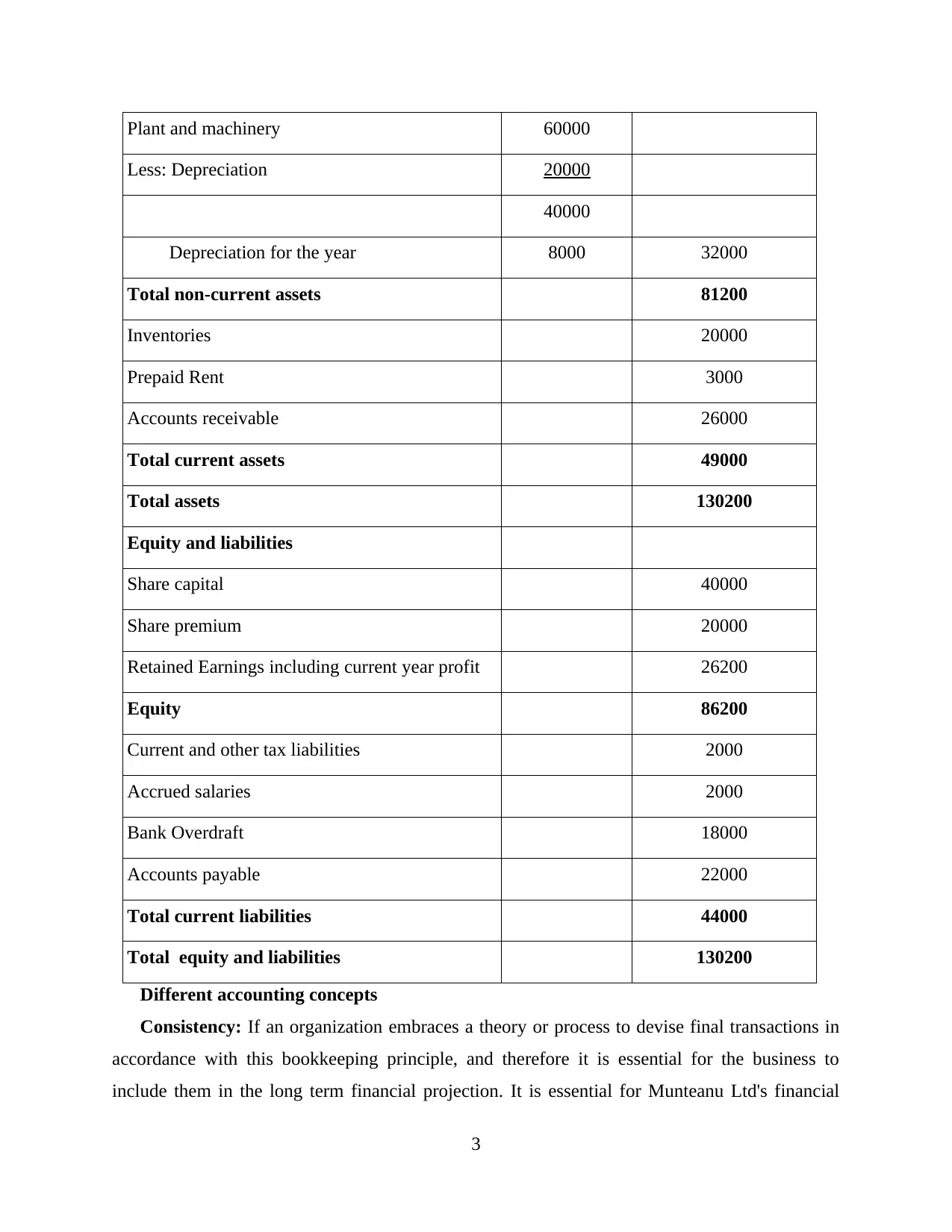
Plant and machinery 60000
Less: Depreciation 20000
40000
Depreciation for the year 8000 32000
Total non-current assets 81200
Inventories 20000
Prepaid Rent 3000
Accounts receivable 26000
Total current assets 49000
Total assets 130200
Equity and liabilities
Share capital 40000
Share premium 20000
Retained Earnings including current year profit 26200
Equity 86200
Current and other tax liabilities 2000
Accrued salaries 2000
Bank Overdraft 18000
Accounts payable 22000
Total current liabilities 44000
Total equity and liabilities 130200
Different accounting concepts
Consistency: If an organization embraces a theory or process to devise final transactions in
accordance with this bookkeeping principle, and therefore it is essential for the business to
include them in the long term financial projection. It is essential for Munteanu Ltd's financial
3
Less: Depreciation 20000
40000
Depreciation for the year 8000 32000
Total non-current assets 81200
Inventories 20000
Prepaid Rent 3000
Accounts receivable 26000
Total current assets 49000
Total assets 130200
Equity and liabilities
Share capital 40000
Share premium 20000
Retained Earnings including current year profit 26200
Equity 86200
Current and other tax liabilities 2000
Accrued salaries 2000
Bank Overdraft 18000
Accounts payable 22000
Total current liabilities 44000
Total equity and liabilities 130200
Different accounting concepts
Consistency: If an organization embraces a theory or process to devise final transactions in
accordance with this bookkeeping principle, and therefore it is essential for the business to
include them in the long term financial projection. It is essential for Munteanu Ltd's financial
3
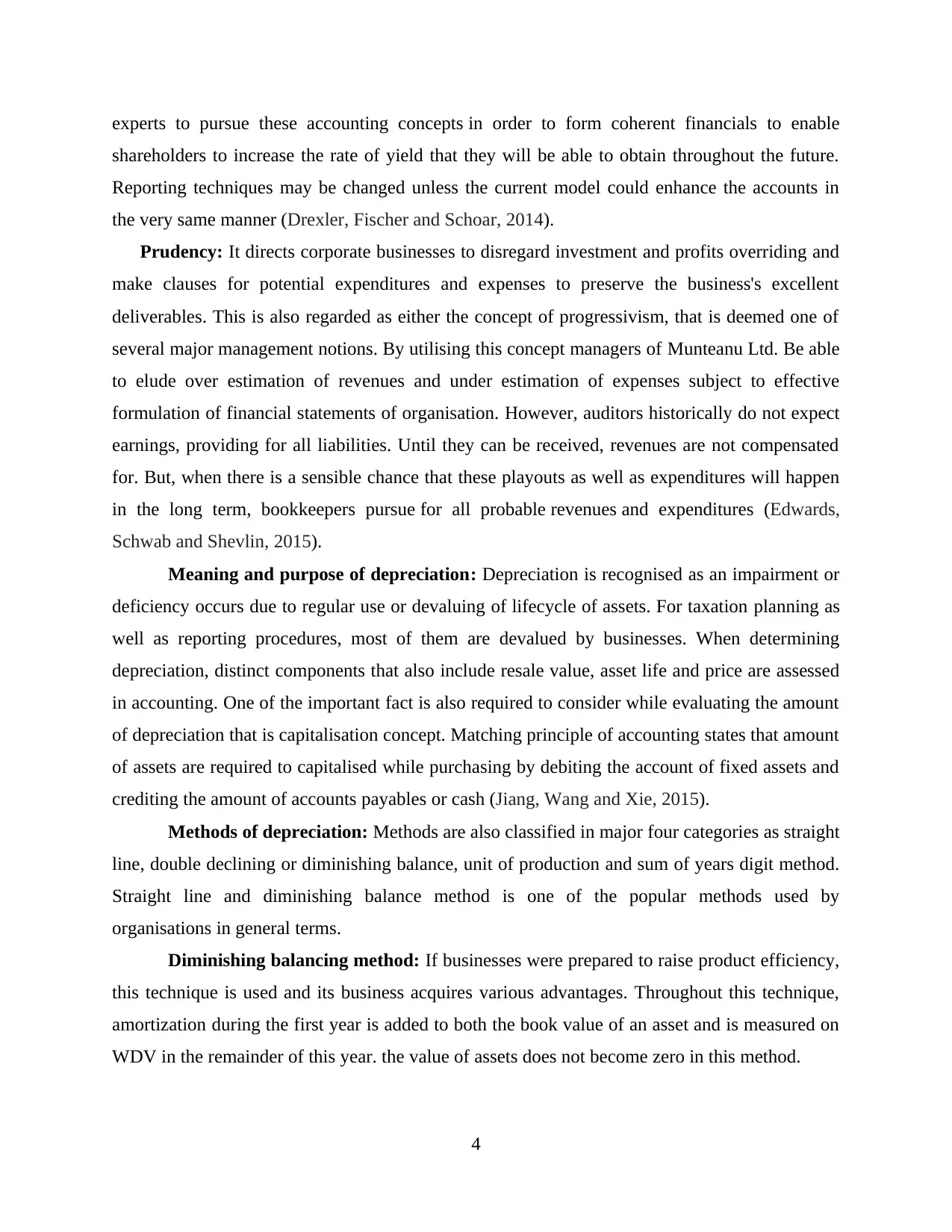
experts to pursue these accounting concepts in order to form coherent financials to enable
shareholders to increase the rate of yield that they will be able to obtain throughout the future.
Reporting techniques may be changed unless the current model could enhance the accounts in
the very same manner (Drexler, Fischer and Schoar, 2014).
Prudency: It directs corporate businesses to disregard investment and profits overriding and
make clauses for potential expenditures and expenses to preserve the business's excellent
deliverables. This is also regarded as either the concept of progressivism, that is deemed one of
several major management notions. By utilising this concept managers of Munteanu Ltd. Be able
to elude over estimation of revenues and under estimation of expenses subject to effective
formulation of financial statements of organisation. However, auditors historically do not expect
earnings, providing for all liabilities. Until they can be received, revenues are not compensated
for. But, when there is a sensible chance that these playouts as well as expenditures will happen
in the long term, bookkeepers pursue for all probable revenues and expenditures (Edwards,
Schwab and Shevlin, 2015).
Meaning and purpose of depreciation: Depreciation is recognised as an impairment or
deficiency occurs due to regular use or devaluing of lifecycle of assets. For taxation planning as
well as reporting procedures, most of them are devalued by businesses. When determining
depreciation, distinct components that also include resale value, asset life and price are assessed
in accounting. One of the important fact is also required to consider while evaluating the amount
of depreciation that is capitalisation concept. Matching principle of accounting states that amount
of assets are required to capitalised while purchasing by debiting the account of fixed assets and
crediting the amount of accounts payables or cash (Jiang, Wang and Xie, 2015).
Methods of depreciation: Methods are also classified in major four categories as straight
line, double declining or diminishing balance, unit of production and sum of years digit method.
Straight line and diminishing balance method is one of the popular methods used by
organisations in general terms.
Diminishing balancing method: If businesses were prepared to raise product efficiency,
this technique is used and its business acquires various advantages. Throughout this technique,
amortization during the first year is added to both the book value of an asset and is measured on
WDV in the remainder of this year. the value of assets does not become zero in this method.
4
shareholders to increase the rate of yield that they will be able to obtain throughout the future.
Reporting techniques may be changed unless the current model could enhance the accounts in
the very same manner (Drexler, Fischer and Schoar, 2014).
Prudency: It directs corporate businesses to disregard investment and profits overriding and
make clauses for potential expenditures and expenses to preserve the business's excellent
deliverables. This is also regarded as either the concept of progressivism, that is deemed one of
several major management notions. By utilising this concept managers of Munteanu Ltd. Be able
to elude over estimation of revenues and under estimation of expenses subject to effective
formulation of financial statements of organisation. However, auditors historically do not expect
earnings, providing for all liabilities. Until they can be received, revenues are not compensated
for. But, when there is a sensible chance that these playouts as well as expenditures will happen
in the long term, bookkeepers pursue for all probable revenues and expenditures (Edwards,
Schwab and Shevlin, 2015).
Meaning and purpose of depreciation: Depreciation is recognised as an impairment or
deficiency occurs due to regular use or devaluing of lifecycle of assets. For taxation planning as
well as reporting procedures, most of them are devalued by businesses. When determining
depreciation, distinct components that also include resale value, asset life and price are assessed
in accounting. One of the important fact is also required to consider while evaluating the amount
of depreciation that is capitalisation concept. Matching principle of accounting states that amount
of assets are required to capitalised while purchasing by debiting the account of fixed assets and
crediting the amount of accounts payables or cash (Jiang, Wang and Xie, 2015).
Methods of depreciation: Methods are also classified in major four categories as straight
line, double declining or diminishing balance, unit of production and sum of years digit method.
Straight line and diminishing balance method is one of the popular methods used by
organisations in general terms.
Diminishing balancing method: If businesses were prepared to raise product efficiency,
this technique is used and its business acquires various advantages. Throughout this technique,
amortization during the first year is added to both the book value of an asset and is measured on
WDV in the remainder of this year. the value of assets does not become zero in this method.
4
⊘ This is a preview!⊘
Do you want full access?
Subscribe today to unlock all pages.

Trusted by 1+ million students worldwide
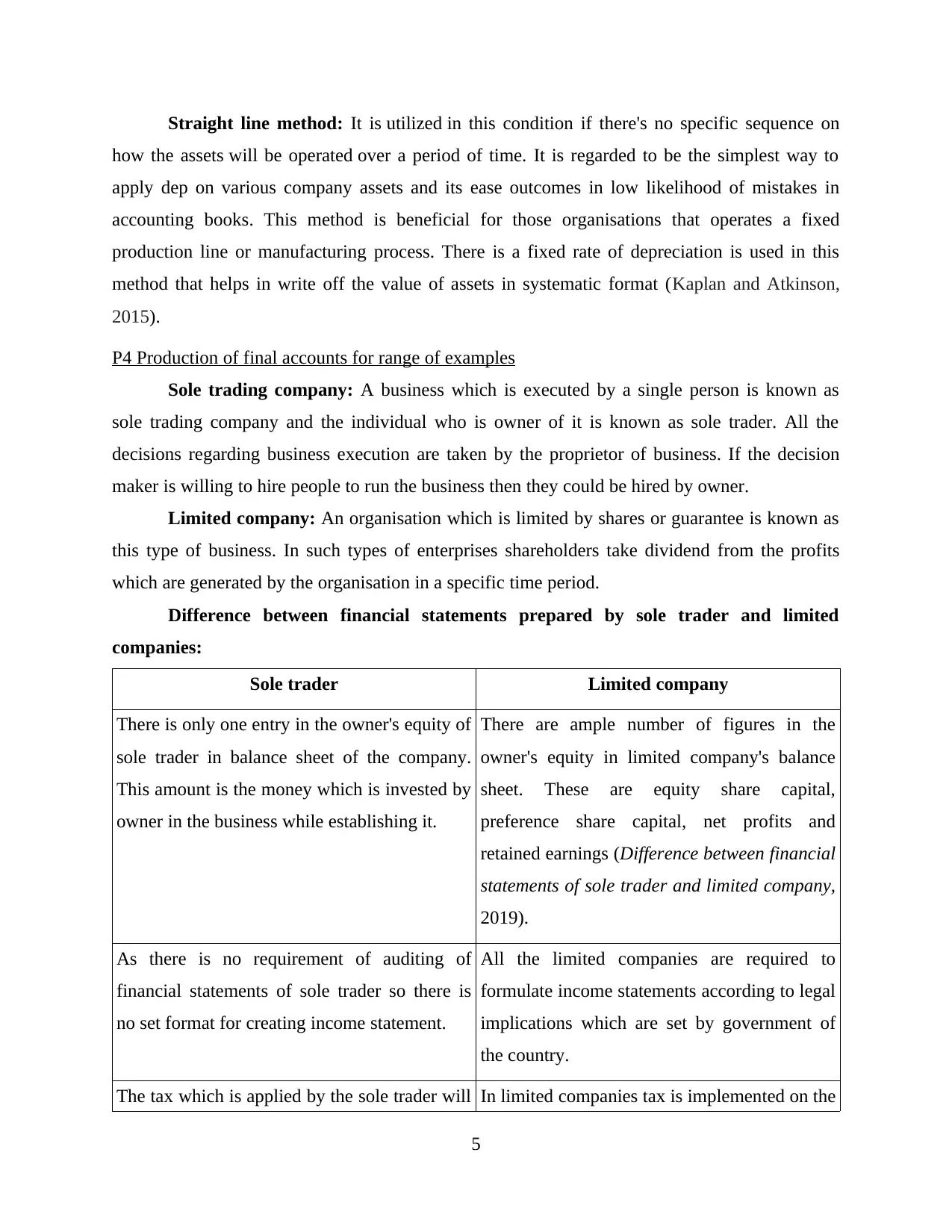
Straight line method: It is utilized in this condition if there's no specific sequence on
how the assets will be operated over a period of time. It is regarded to be the simplest way to
apply dep on various company assets and its ease outcomes in low likelihood of mistakes in
accounting books. This method is beneficial for those organisations that operates a fixed
production line or manufacturing process. There is a fixed rate of depreciation is used in this
method that helps in write off the value of assets in systematic format (Kaplan and Atkinson,
2015).
P4 Production of final accounts for range of examples
Sole trading company: A business which is executed by a single person is known as
sole trading company and the individual who is owner of it is known as sole trader. All the
decisions regarding business execution are taken by the proprietor of business. If the decision
maker is willing to hire people to run the business then they could be hired by owner.
Limited company: An organisation which is limited by shares or guarantee is known as
this type of business. In such types of enterprises shareholders take dividend from the profits
which are generated by the organisation in a specific time period.
Difference between financial statements prepared by sole trader and limited
companies:
Sole trader Limited company
There is only one entry in the owner's equity of
sole trader in balance sheet of the company.
This amount is the money which is invested by
owner in the business while establishing it.
There are ample number of figures in the
owner's equity in limited company's balance
sheet. These are equity share capital,
preference share capital, net profits and
retained earnings (Difference between financial
statements of sole trader and limited company,
2019).
As there is no requirement of auditing of
financial statements of sole trader so there is
no set format for creating income statement.
All the limited companies are required to
formulate income statements according to legal
implications which are set by government of
the country.
The tax which is applied by the sole trader will In limited companies tax is implemented on the
5
how the assets will be operated over a period of time. It is regarded to be the simplest way to
apply dep on various company assets and its ease outcomes in low likelihood of mistakes in
accounting books. This method is beneficial for those organisations that operates a fixed
production line or manufacturing process. There is a fixed rate of depreciation is used in this
method that helps in write off the value of assets in systematic format (Kaplan and Atkinson,
2015).
P4 Production of final accounts for range of examples
Sole trading company: A business which is executed by a single person is known as
sole trading company and the individual who is owner of it is known as sole trader. All the
decisions regarding business execution are taken by the proprietor of business. If the decision
maker is willing to hire people to run the business then they could be hired by owner.
Limited company: An organisation which is limited by shares or guarantee is known as
this type of business. In such types of enterprises shareholders take dividend from the profits
which are generated by the organisation in a specific time period.
Difference between financial statements prepared by sole trader and limited
companies:
Sole trader Limited company
There is only one entry in the owner's equity of
sole trader in balance sheet of the company.
This amount is the money which is invested by
owner in the business while establishing it.
There are ample number of figures in the
owner's equity in limited company's balance
sheet. These are equity share capital,
preference share capital, net profits and
retained earnings (Difference between financial
statements of sole trader and limited company,
2019).
As there is no requirement of auditing of
financial statements of sole trader so there is
no set format for creating income statement.
All the limited companies are required to
formulate income statements according to legal
implications which are set by government of
the country.
The tax which is applied by the sole trader will In limited companies tax is implemented on the
5
Paraphrase This Document
Need a fresh take? Get an instant paraphrase of this document with our AI Paraphraser
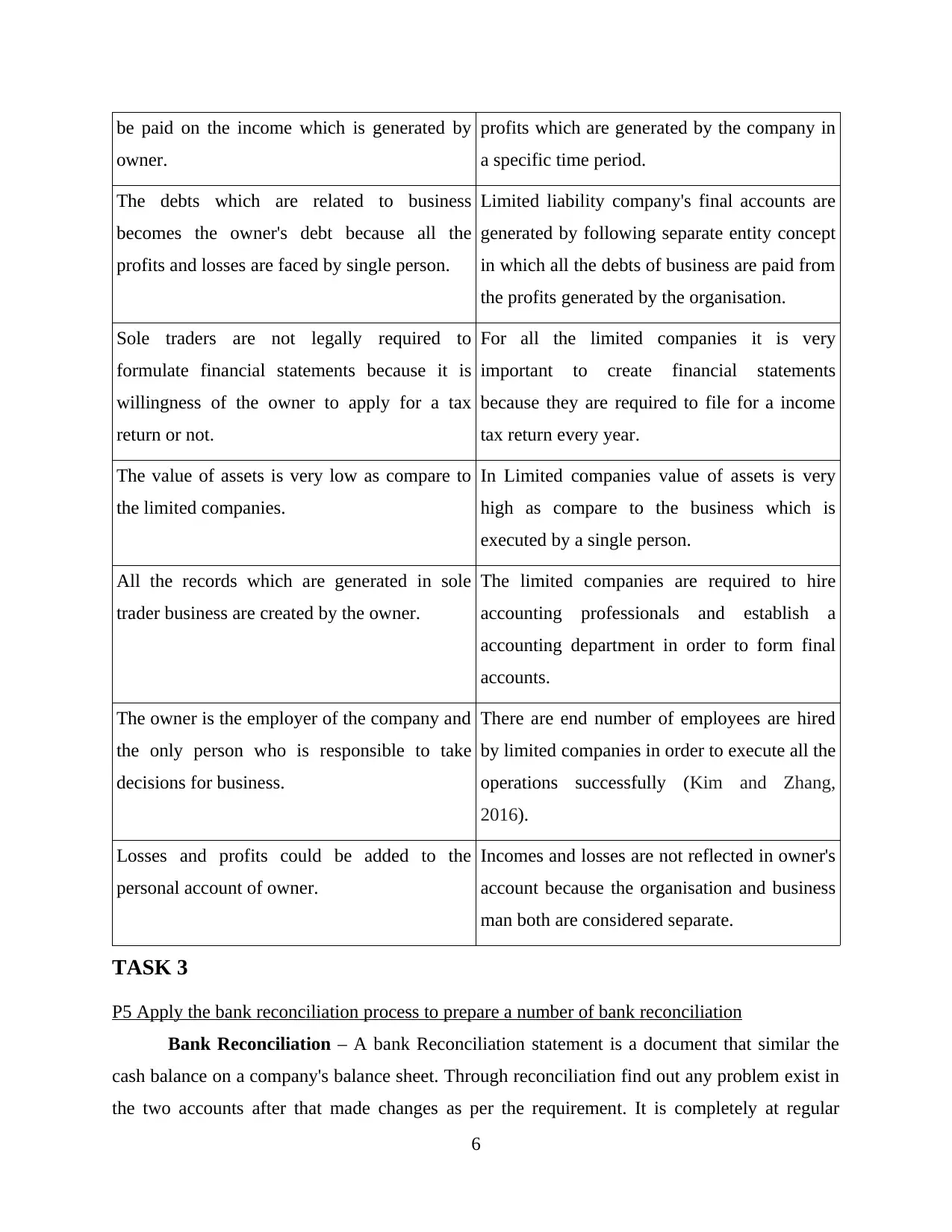
be paid on the income which is generated by
owner.
profits which are generated by the company in
a specific time period.
The debts which are related to business
becomes the owner's debt because all the
profits and losses are faced by single person.
Limited liability company's final accounts are
generated by following separate entity concept
in which all the debts of business are paid from
the profits generated by the organisation.
Sole traders are not legally required to
formulate financial statements because it is
willingness of the owner to apply for a tax
return or not.
For all the limited companies it is very
important to create financial statements
because they are required to file for a income
tax return every year.
The value of assets is very low as compare to
the limited companies.
In Limited companies value of assets is very
high as compare to the business which is
executed by a single person.
All the records which are generated in sole
trader business are created by the owner.
The limited companies are required to hire
accounting professionals and establish a
accounting department in order to form final
accounts.
The owner is the employer of the company and
the only person who is responsible to take
decisions for business.
There are end number of employees are hired
by limited companies in order to execute all the
operations successfully (Kim and Zhang,
2016).
Losses and profits could be added to the
personal account of owner.
Incomes and losses are not reflected in owner's
account because the organisation and business
man both are considered separate.
TASK 3
P5 Apply the bank reconciliation process to prepare a number of bank reconciliation
Bank Reconciliation – A bank Reconciliation statement is a document that similar the
cash balance on a company's balance sheet. Through reconciliation find out any problem exist in
the two accounts after that made changes as per the requirement. It is completely at regular
6
owner.
profits which are generated by the company in
a specific time period.
The debts which are related to business
becomes the owner's debt because all the
profits and losses are faced by single person.
Limited liability company's final accounts are
generated by following separate entity concept
in which all the debts of business are paid from
the profits generated by the organisation.
Sole traders are not legally required to
formulate financial statements because it is
willingness of the owner to apply for a tax
return or not.
For all the limited companies it is very
important to create financial statements
because they are required to file for a income
tax return every year.
The value of assets is very low as compare to
the limited companies.
In Limited companies value of assets is very
high as compare to the business which is
executed by a single person.
All the records which are generated in sole
trader business are created by the owner.
The limited companies are required to hire
accounting professionals and establish a
accounting department in order to form final
accounts.
The owner is the employer of the company and
the only person who is responsible to take
decisions for business.
There are end number of employees are hired
by limited companies in order to execute all the
operations successfully (Kim and Zhang,
2016).
Losses and profits could be added to the
personal account of owner.
Incomes and losses are not reflected in owner's
account because the organisation and business
man both are considered separate.
TASK 3
P5 Apply the bank reconciliation process to prepare a number of bank reconciliation
Bank Reconciliation – A bank Reconciliation statement is a document that similar the
cash balance on a company's balance sheet. Through reconciliation find out any problem exist in
the two accounts after that made changes as per the requirement. It is completely at regular
6
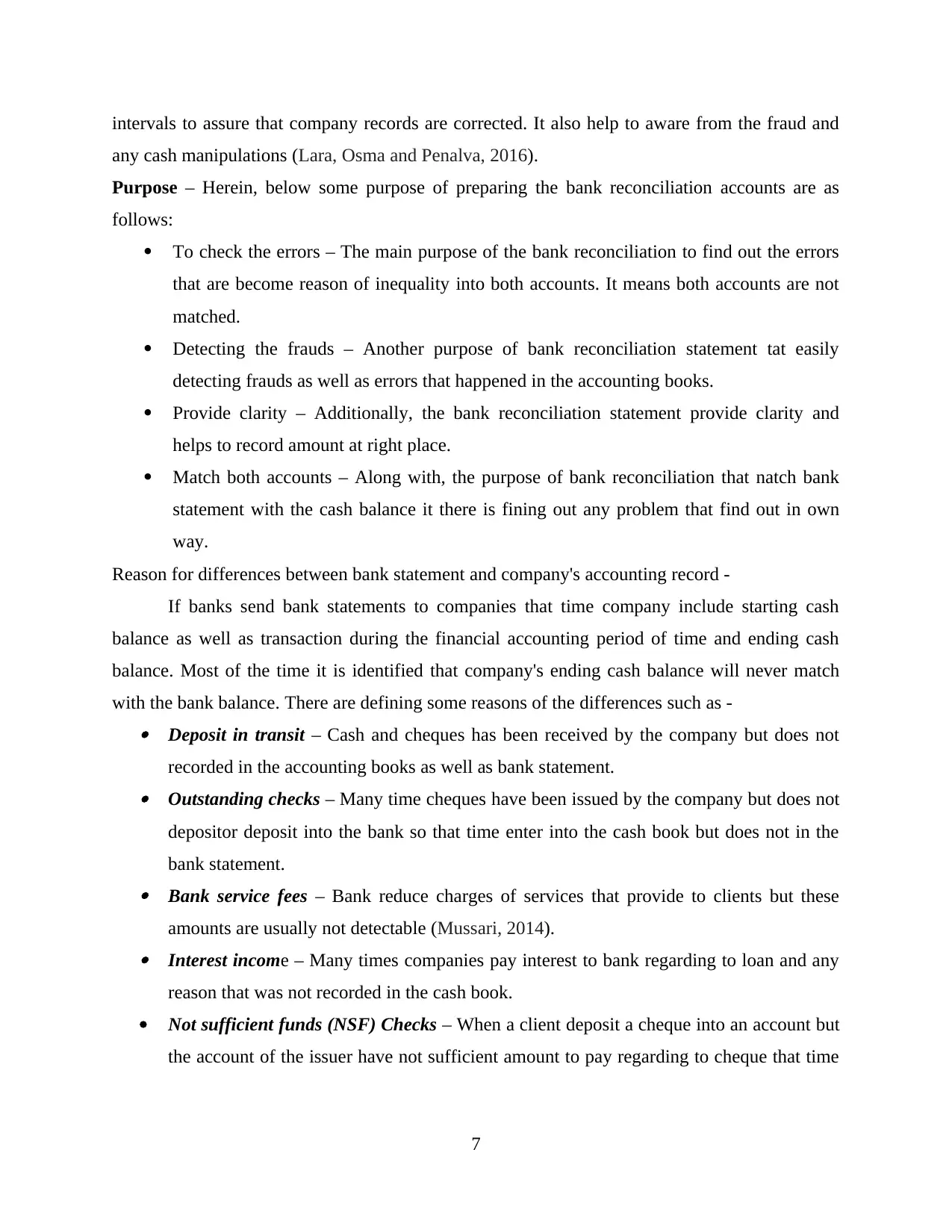
intervals to assure that company records are corrected. It also help to aware from the fraud and
any cash manipulations (Lara, Osma and Penalva, 2016).
Purpose – Herein, below some purpose of preparing the bank reconciliation accounts are as
follows:
To check the errors – The main purpose of the bank reconciliation to find out the errors
that are become reason of inequality into both accounts. It means both accounts are not
matched.
Detecting the frauds – Another purpose of bank reconciliation statement tat easily
detecting frauds as well as errors that happened in the accounting books.
Provide clarity – Additionally, the bank reconciliation statement provide clarity and
helps to record amount at right place.
Match both accounts – Along with, the purpose of bank reconciliation that natch bank
statement with the cash balance it there is fining out any problem that find out in own
way.
Reason for differences between bank statement and company's accounting record -
If banks send bank statements to companies that time company include starting cash
balance as well as transaction during the financial accounting period of time and ending cash
balance. Most of the time it is identified that company's ending cash balance will never match
with the bank balance. There are defining some reasons of the differences such as - Deposit in transit – Cash and cheques has been received by the company but does not
recorded in the accounting books as well as bank statement. Outstanding checks – Many time cheques have been issued by the company but does not
depositor deposit into the bank so that time enter into the cash book but does not in the
bank statement. Bank service fees – Bank reduce charges of services that provide to clients but these
amounts are usually not detectable (Mussari, 2014). Interest income – Many times companies pay interest to bank regarding to loan and any
reason that was not recorded in the cash book.
Not sufficient funds (NSF) Checks – When a client deposit a cheque into an account but
the account of the issuer have not sufficient amount to pay regarding to cheque that time
7
any cash manipulations (Lara, Osma and Penalva, 2016).
Purpose – Herein, below some purpose of preparing the bank reconciliation accounts are as
follows:
To check the errors – The main purpose of the bank reconciliation to find out the errors
that are become reason of inequality into both accounts. It means both accounts are not
matched.
Detecting the frauds – Another purpose of bank reconciliation statement tat easily
detecting frauds as well as errors that happened in the accounting books.
Provide clarity – Additionally, the bank reconciliation statement provide clarity and
helps to record amount at right place.
Match both accounts – Along with, the purpose of bank reconciliation that natch bank
statement with the cash balance it there is fining out any problem that find out in own
way.
Reason for differences between bank statement and company's accounting record -
If banks send bank statements to companies that time company include starting cash
balance as well as transaction during the financial accounting period of time and ending cash
balance. Most of the time it is identified that company's ending cash balance will never match
with the bank balance. There are defining some reasons of the differences such as - Deposit in transit – Cash and cheques has been received by the company but does not
recorded in the accounting books as well as bank statement. Outstanding checks – Many time cheques have been issued by the company but does not
depositor deposit into the bank so that time enter into the cash book but does not in the
bank statement. Bank service fees – Bank reduce charges of services that provide to clients but these
amounts are usually not detectable (Mussari, 2014). Interest income – Many times companies pay interest to bank regarding to loan and any
reason that was not recorded in the cash book.
Not sufficient funds (NSF) Checks – When a client deposit a cheque into an account but
the account of the issuer have not sufficient amount to pay regarding to cheque that time
7
⊘ This is a preview!⊘
Do you want full access?
Subscribe today to unlock all pages.

Trusted by 1+ million students worldwide
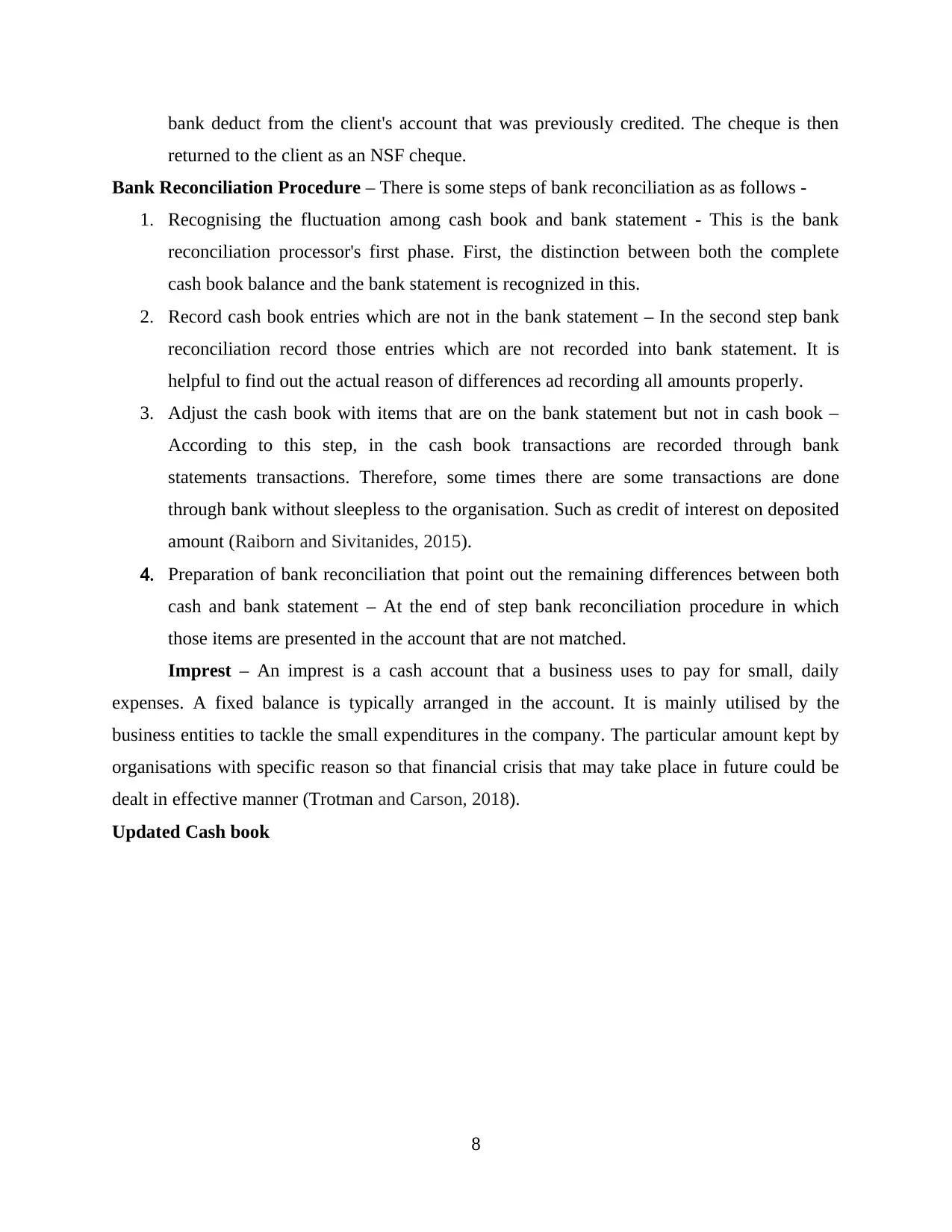
bank deduct from the client's account that was previously credited. The cheque is then
returned to the client as an NSF cheque.
Bank Reconciliation Procedure – There is some steps of bank reconciliation as as follows -
1. Recognising the fluctuation among cash book and bank statement - This is the bank
reconciliation processor's first phase. First, the distinction between both the complete
cash book balance and the bank statement is recognized in this.
2. Record cash book entries which are not in the bank statement – In the second step bank
reconciliation record those entries which are not recorded into bank statement. It is
helpful to find out the actual reason of differences ad recording all amounts properly.
3. Adjust the cash book with items that are on the bank statement but not in cash book –
According to this step, in the cash book transactions are recorded through bank
statements transactions. Therefore, some times there are some transactions are done
through bank without sleepless to the organisation. Such as credit of interest on deposited
amount (Raiborn and Sivitanides, 2015).
4. Preparation of bank reconciliation that point out the remaining differences between both
cash and bank statement – At the end of step bank reconciliation procedure in which
those items are presented in the account that are not matched.
Imprest – An imprest is a cash account that a business uses to pay for small, daily
expenses. A fixed balance is typically arranged in the account. It is mainly utilised by the
business entities to tackle the small expenditures in the company. The particular amount kept by
organisations with specific reason so that financial crisis that may take place in future could be
dealt in effective manner (Trotman and Carson, 2018).
Updated Cash book
8
returned to the client as an NSF cheque.
Bank Reconciliation Procedure – There is some steps of bank reconciliation as as follows -
1. Recognising the fluctuation among cash book and bank statement - This is the bank
reconciliation processor's first phase. First, the distinction between both the complete
cash book balance and the bank statement is recognized in this.
2. Record cash book entries which are not in the bank statement – In the second step bank
reconciliation record those entries which are not recorded into bank statement. It is
helpful to find out the actual reason of differences ad recording all amounts properly.
3. Adjust the cash book with items that are on the bank statement but not in cash book –
According to this step, in the cash book transactions are recorded through bank
statements transactions. Therefore, some times there are some transactions are done
through bank without sleepless to the organisation. Such as credit of interest on deposited
amount (Raiborn and Sivitanides, 2015).
4. Preparation of bank reconciliation that point out the remaining differences between both
cash and bank statement – At the end of step bank reconciliation procedure in which
those items are presented in the account that are not matched.
Imprest – An imprest is a cash account that a business uses to pay for small, daily
expenses. A fixed balance is typically arranged in the account. It is mainly utilised by the
business entities to tackle the small expenditures in the company. The particular amount kept by
organisations with specific reason so that financial crisis that may take place in future could be
dealt in effective manner (Trotman and Carson, 2018).
Updated Cash book
8
Paraphrase This Document
Need a fresh take? Get an instant paraphrase of this document with our AI Paraphraser
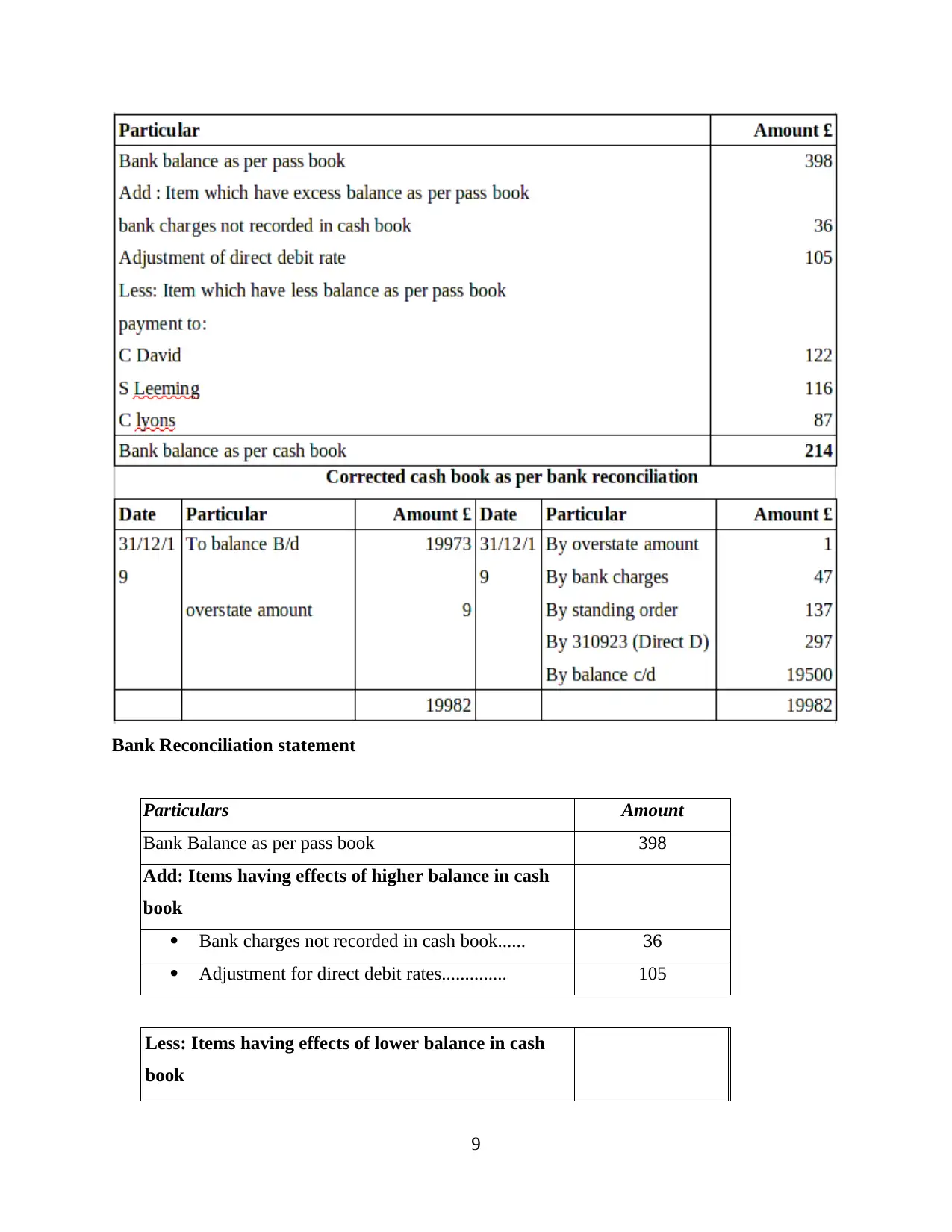
Bank Reconciliation statement
Particulars Amount
Bank Balance as per pass book 398
Add: Items having effects of higher balance in cash
book
Bank charges not recorded in cash book...... 36
Adjustment for direct debit rates.............. 105
Less: Items having effects of lower balance in cash
book
9
Particulars Amount
Bank Balance as per pass book 398
Add: Items having effects of higher balance in cash
book
Bank charges not recorded in cash book...... 36
Adjustment for direct debit rates.............. 105
Less: Items having effects of lower balance in cash
book
9
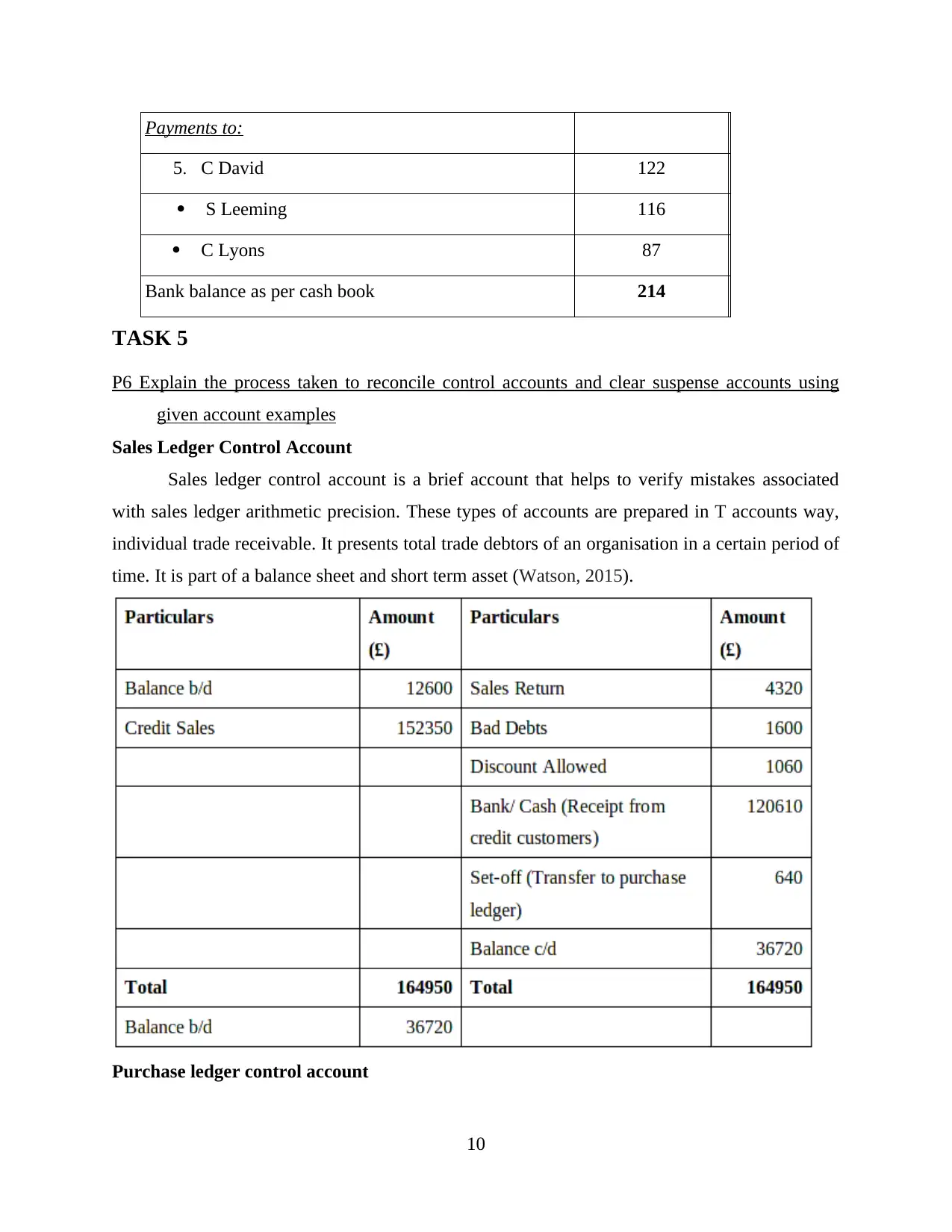
Payments to:
5. C David 122
S Leeming 116
C Lyons 87
Bank balance as per cash book 214
TASK 5
P6 Explain the process taken to reconcile control accounts and clear suspense accounts using
given account examples
Sales Ledger Control Account
Sales ledger control account is a brief account that helps to verify mistakes associated
with sales ledger arithmetic precision. These types of accounts are prepared in T accounts way,
individual trade receivable. It presents total trade debtors of an organisation in a certain period of
time. It is part of a balance sheet and short term asset (Watson, 2015).
Purchase ledger control account
10
5. C David 122
S Leeming 116
C Lyons 87
Bank balance as per cash book 214
TASK 5
P6 Explain the process taken to reconcile control accounts and clear suspense accounts using
given account examples
Sales Ledger Control Account
Sales ledger control account is a brief account that helps to verify mistakes associated
with sales ledger arithmetic precision. These types of accounts are prepared in T accounts way,
individual trade receivable. It presents total trade debtors of an organisation in a certain period of
time. It is part of a balance sheet and short term asset (Watson, 2015).
Purchase ledger control account
10
⊘ This is a preview!⊘
Do you want full access?
Subscribe today to unlock all pages.

Trusted by 1+ million students worldwide
1 out of 15
Related Documents
Your All-in-One AI-Powered Toolkit for Academic Success.
+13062052269
info@desklib.com
Available 24*7 on WhatsApp / Email
![[object Object]](/_next/static/media/star-bottom.7253800d.svg)
Unlock your academic potential
Copyright © 2020–2025 A2Z Services. All Rights Reserved. Developed and managed by ZUCOL.





